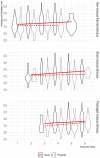Eyes on Newborns: How NICU Staff's Attention and Emotions Shape Neonatal Pain Assessment
- PMID: 39899268
- PMCID: PMC11789839
- DOI: 10.1002/ejp.4791
Eyes on Newborns: How NICU Staff's Attention and Emotions Shape Neonatal Pain Assessment
Abstract
Background: Assessing pain in neonates is crucial for their management but is inherently subjective. This study investigated the effects of visual attention, gaze patterns, and empathic responses of neonatal healthcare professionals on their assessments of neonatal pain.
Methods: Conducted at the Department of Neonatology, University Medical Center Hamburg-Eppendorf, we employed eye-tracking to monitor staff's responses to videos depicting neonates experiencing non-noxious thermal, brief noxious, and prolonged noxious stimuli. Videos were presented in two formats: full body view, providing contextual information, and face-only view, lacking contextual details. Pain assessments were measured using a Faces Pain Rating Scale (FPRS), exploring the impacts of contextual cues, professional experience, and job roles.
Results: The study found brief and prolonged noxious stimuli eliciting significantly higher FPRS scores compared to non-painful stimuli, with the full body view resulting in higher pain ratings than the face-only view. The mouth region attracted focused attention. Nurses generally reported higher pain scores and exhibited larger pupil diameters compared to physicians, suggesting a stronger empathic response.
Conclusion: This research highlights the essential role of visual cues and empathic responses in neonatal pain assessment, demonstrating how professional roles and stimulus presentation format impact evaluations, and underlining the need for standardised protocols to improve neonatal pain management accuracy.
Significance: The study emphasises the importance of visual cues and empathy in neonatal pain assessment, highlighting the roles of healthcare professionals and stimulus presentation formats. It addresses challenges in understanding neonatal pain, advocating for standardised protocols. Using eye-tracking technology, the research explores how professionals' visual attention and empathy affect pain evaluations, suggesting more objective assessment methods.
Keywords: NICU; emotion; eye‐tracking; newborn; pain assessment; pupil diameter; visual attention.
© 2025 The Author(s). European Journal of Pain published by John Wiley & Sons Ltd on behalf of European Pain Federation ‐ EFIC ®.
Conflict of interest statement
The authors declare no conflicts of interest.
Figures





Similar articles
-
Comparative analysis of artificial intelligence and expert assessments in detecting neonatal procedural pain.Sci Rep. 2024 Sep 2;14(1):20374. doi: 10.1038/s41598-024-71278-6. Sci Rep. 2024. PMID: 39223215 Free PMC article.
-
Healthcare professionals' perceptions of pain in infants at risk for neurological impairment.BMC Pediatr. 2004 Nov 12;4(1):23. doi: 10.1186/1471-2431-4-23. BMC Pediatr. 2004. PMID: 15541179 Free PMC article. Clinical Trial.
-
The effect of emotional information from eyes on empathy for pain: A subliminal ERP study.PLoS One. 2019 Dec 13;14(12):e0226211. doi: 10.1371/journal.pone.0226211. eCollection 2019. PLoS One. 2019. PMID: 31834900 Free PMC article.
-
Challenges in the pain assessment during neonatal transport: an update.Minerva Pediatr. 2018 Aug;70(4):403-407. doi: 10.23736/S0026-4946.16.04636-3. Epub 2016 May 20. Minerva Pediatr. 2018. PMID: 27198493 Review.
-
Prolonged pain in premature neonates hospitalised in neonatal intensive care units: A scoping review.Int J Nurs Stud. 2024 Jul;155:104773. doi: 10.1016/j.ijnurstu.2024.104773. Epub 2024 Apr 17. Int J Nurs Stud. 2024. PMID: 38718692
References
-
- Ayiei, A. 2020. “The Use of Eye Tracking in Assessing Visual Attention.” Journal of Aircraft and Spacecraft Technology 4, no. 1: 117–124. 10.3844/jastsp.2020.117.124. - DOI
-
- Boyd, D. , Butler M., Carr D., et al. 2023. “Taxonomy: IASP Pain Terminology.” https://www.iasp‐pain.org/resources/terminology/#pain.
-
- Buonocore, G. B. C. V. 2008. Neonatal Pain. 1st ed. Springer. 10.1007/978-88-470-0732-1. - DOI
MeSH terms
LinkOut - more resources
Full Text Sources
Medical

